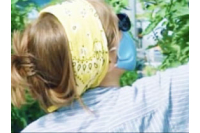The future of sustainable packaging is bioplastic produced from photosynthesizing organisms. Fossil fuel based plastic is dangerous. It is harmful to human, wildlife and ecosystem health. Microplastics are both physical and chemical contaminants when consumed by humans or wildlife. As plastic is degraded by the elements the synthetic polymers and the persistent organic pollutants that make them up are released. Doubling fish consumption as advised by The Dietary Guidelines for Americans, will double your consumption of the following persistent organic pollutants: idrin, chlordane, DDT, dieldrin, endrin, heptachlor and so many more. This will result in cancer, nervous system effects, reproductive issues, disruption of thyroid function, harmful effects on liver and other organs, and increased risk for chronic disease.
In addition to being a human carcinogen, broken down plastic polymers have an incomprehensible environmental toll. We have yet to see how we have ravaged. Plastic islands block out the sun for marine photosynthesizing organisms. Fifty to eighty percent of our oxygen is produced by them, according to the National Oceanic Association (NOA). Plastic waste in the ocean contributes to acifiction by altering water chemistry and giving surface area to harmful bacteria such as Photobacterium rosenbergii, which is associated with coral bleaching. Biodiversity is demolished when members of the population die from plastic consumption and/or invasive species are transported by ocean litter. In the near future our soils will be desolate, our water undrinkable and our planet will be unlivable.
This current method of consumption cannot be readily replaced by natural means Plant and microalgae biopolymers can provide sustainable packaging. For example, polymeric polyhydroxybutyrates are currently used for surgical stitches. It may have the capability to be used like one of it’s synthetic non-biodegradable counterparts, Ethylene Polyester, in textiles and packaging. The use of non-petrochemical oils and cellulose extracted from algae for packaging, fuel and pigments is in small-scale practice. Edible and biodegradable seaweed based packaging is utilized currently in the UK food service industry for condiment sachets and pipettes.
As of recently, hemp, corn and other plant based packaging is also available. Hemp and all the species of the Cannabis genus have a high cellulose content within its biomass and an efficient production period (roughly four months) making it ideal for bioplastic. Cellulose is most effectively harvested from the stalks. In the 2020 election, fifteen states legalized recreational marijuana. That gives way to an excess in biomass and a need for single use packaging. We need radical change in policy and polymers. With bioplastics we can have a future. A future where we can continue to breathe, eat fish, listen to the birds, and play in the soil. A future that will leave our children proud. A future where we can not only survive but thrive.
Essay by: Gabrielle Rael
Arizona State University

